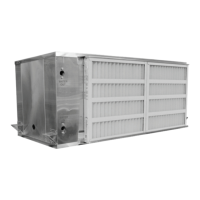28
Maximum Overcurrent Protection (MOP)
shown on the unit nameplate.
Codes may require a disconnect switch be
within sight of the unit.
A unit-mounted disconnect switch is
available as an option. It is important to note
that this is a method for convenient
maintenance of the unit, but does not
provide unit protection or isolation.
Electrical supply can enter through the side
of the controls compartment where
knockouts and/or capped pre-cut holes have
been provided. Horizontal units have been
provided with both high and low voltage
holes at the top and bottom of the unit. Entry
must be made into one each of these
locations.
A single point connection to a definite
purpose contactor is provided on the control
panel, or to the unit-mounted disconnect
switch (if installed) on the corner panel.
High voltage conductors must enter the
control panel in a separate opening and
separate conduit than 24V low voltage
conductors. High voltage and low voltage
openings are nominally sized at 1-1/8” and
7/8” respectively.
Note: Alternate locations for field cut
electrical entries must be approved by
AAON factory.
Size supply conductors based on the unit
Minimum Current Ampacity (MCA) rating.
Supply conductors must be rated a minimum
of 75°C.
Protect the branch circuit in accordance with
code requirements. The unit must be
electrically grounded in accordance with
local codes, or in the absence of local codes,
the current National Electric Code,
ANSI/NFPA 70 or the current Canadian
Electrical Code CSA C22.1.
Wire power leads to the unit’s contactor or
main disconnect. All wiring beyond this
point has been completed by AAON and
cannot be modified without effecting the
unit’s agency/safety certification.
Supply voltage must be within the min/max
range shown on the unit nameplate.
Available short circuit current must not
exceed the short circuit current rating
(SCCR) shown on the unit nameplate.
Voltage imbalance is defined as 100 times
the maximum deviation from the average
voltage divided by the average voltage. The
maximum allowable imbalance is 5%.
Example:
(218V+237V+235V)/3 = 230V, then
100*(230V-218V)/230V = 5.2%, which
exceeds the allowable imbalance.
Check voltage imbalance at the unit
disconnect switch and at the compressor
terminal. Contact your local power company
for line voltage corrections.
Installing Contractor is responsible
for proper sealing of the electrical
entries into the unit. Failure to seal
the entries may result in damage to
Three phase voltage imbalance will
cause motor overheating and
premature failure.

